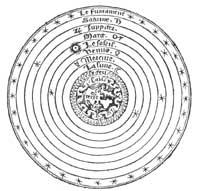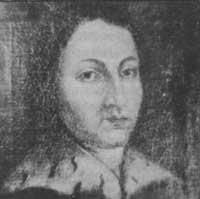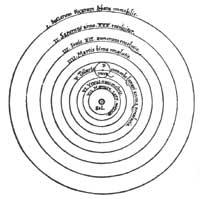The Copernican Revolution
The cosmological-astromonic tradition from Greece through the Arabs to western Europe was mainly based on two names. On the one hand, Aristotle, the last great classical cosmologist and philosopher who had a broader and deeper influence on the thinking of the Middle Ages, and to some extent the Renaissance. Its importance is reflected in the work of all future scientists and philosophers by the complete and systematic construction of the wisdom of their time and by the basic unity between man and the universe.

Moreover, and separated from Aristotle for a period of five centuries, we have the name of Ptolemy, who without lips is the summit of classical astronomy. Ptolemy, who accepted Aristotelian physics, dealt with the mathematical structure of astronomical problems (excluding mechanical aspects, i.e. physicists). In Ptolemy's works no reference is made to the cause of the movement of the bodies of the mass or to the nature of the universe or to the laws governing its parts. Thus, Ptolemy's aim was to express and predict the movements of the bodies of kneading by combinations of certain circular and uniform movements.
Of course, Ptolomean theory also had its enemies in the classical world and used its tools (epicycles and eccentric to. C.). III and II. The geometric instruments created by Apollonius and Hiparkus for centuries, and the equant, devised by Ptolemy himself, collided with the other geometrical pathway widespread at that time, that of the homocentric spheres. However, finally, Ptolomean astronomy stands above all others and stands in the XVI. It remained firm until the 19th century.
Therefore, at the dawn of the Renaissance revolution, as a system of reference of wisdom in this matter, they had the cosmology of Aristotle, especially indicated in his works “Physics” and “Coelo”, and with the astronomy of Ptolemy, collected in his “Almagest”.
But these sources were not at the same level. Despite being both points of reference, Ptolomean astronomy did not know substantial changes, that is, its conceptual scheme was not questioned. The same cannot be said of Aristotelian cosmology. After Ptolemy and until the arrival of Copernicus no other important astronomical treatise appeared.
Thus, while Ptolemy's work came into the hands of Renaissance astronomers in its entirety and with all authority, Aristotle's cosmology came to be discussed in some way. This debate included, above all, the theory of its elements, the qualitative foundations of its physics, ideas about its movements and the distinction between its world of upbringing and the world of source.

Although before modern science the relationship between astronomy and cosmology is highlighted, this second field was more appropriate to develop philosophical responsibility than the other. The construction of a system that reflects in its entirety the elements that compose it and its interrelations, constituted a competence of great contribution to human intelligence. At this time, and taking into account the level of scientific thought, the influence of the cosmological models that some thinkers developed must be considered as fundamental. In this sense we must take into account the importance of the work of Niquola de Cusa for the development of astronomy.
The Cardinal Nikola of Cusa (1401-1464) was of neoplatonic and neo-Platonic current in force in the Renaissance period. The Universe has no limits. Among other things, borders would go against the power of all God. This judgment breaks the cosmic hierarchy. Therefore, according to this “the center is everywhere and the circle nowhere”. The Cusano’s reasoning was mystical and his thought is found especially in the work “De docta ignorantia”. For him appearances that do not imply the infinity of God or the knowledge established academically have no importance. And although this does not have the spirit of scientificity, its importance is undeniable, since it turned upside down to the Aristotelian-Ptolomean cosmology approved at that time.
A universe without borders has no center, it can be any center with the same rights. Therefore, the superior or the inferior, the right and the left, fundamental in Aristotelian physics, completely lose their meaning the ideas of back and forth. The Earth must not be at the bottom of the stars, for all bodies in the Cosmos are of the same level. The differentiation between a world of impugnable and perfect kneading and the earthly world disappears. The revolution that could be the reflection of the cusano was so great that, except for the Leonardo de Vinci, he only achieved the rejection of his contemporaries.
Copernicus
Although Ptolemy’s “astronomical theory” has often been discussed, as if Ptolemy had made a complete system of representation of the movements of the kneading bodies, it did not actually occur, i.e. there is no complete systematic theory of Ptolemy. This caused a mathematical tool to be used to somehow express the movement of each kneading body, but it often had to be different in one body or another to match the data.
For this reason, in some cases the resolution that faced a problem was contrary to that which it had to adopt in the other. According to the work of Ptolemy and the school that comes from him, the objective was simply to “pull the phenomena forward”, that is, that the positions of the kneading bodies that were seen could be expected through the constructed theory, even if it was not coherent or founded on any foundation.

The cuts Ptolemy had to make were never against the basic principle of Plato approved by Aristotle in his physics. According to this principle, although the movement of the kneading bodies seems complicated, they were finally indicated by uniform circular motion combinations. Although Ptolemy, in his third book of Almagest, manifested the acceptance of this principle, when he had to accurately develop the trajectories of the planets, the uniformity of the movements would be nothing more than apparent, and the centers of the eccentric would adapt them as he wanted. He also invented the other compensatory instrument when he needed, the equants. To justify in some way this lack of uniformity and systematic will tell us: “the astronomer has to try... that his hypotheses... and the movements of the kneading bodies coincide... but if he does not succeed he will accept the necessary hypotheses”.
All this, on the one hand, and on the other, the inadequacy of the instruments to be approved to express discrepancies between theory and observations, or the lack of skill of astronomers, had to be concluded that the theory itself was never questioned. Renaissance astronomers had this competition in front. It was accepted by Copernicus and the answer was “De revolutionibus orbium coelestium”.
Polish mathematician and astronomer Mikolaj Kopernik (1473-1543) beat his name in the form of “Copernicus”. Throughout his life he made very few observations, a maximum of one hundred, and not all used them to make his “De revolutionibus”. His work is a purely mathematical work. After studying in the faculty of literature of the University of Krakow, Kopernik went to Bologna to study the laws. But both in one and the other he contacted local astronomers.
The master lines of his astronomical system seem to come long before writing “De revolutionibus”, twenty-five years earlier. After his return from Italy, where he was between 1500 and 1504, Copernic wrote and disseminated a pamphlet known as “Commentariolus”. This book contains a brief and clear outline of the principles of your system. After a critique of the theories of his time, taking as a starting point the inlogicity of the Ptolemy system and to eliminate it, he laid seven foundations:
- Not all spheres or kneading circles have a single center.
- The center of the Earth is not of the Universe, but of the orbit of gravity and the moon.
- All spheres revolve around the Sun, this is its center and therefore the Sun is the center of the Universe.
- The relationship between the distance from Earth to the Sun and the distance from Earth to the limit of the universe is very small. Therefore, the first is not noticeable against the kneading height.
- The movement that indicates the kneading does not come from it, but from the Earth movement. The Earth, together with the elements that surround her, makes every day a complete return to herself, while the kneading and the higher sky remain still.
- Those we see as the movement of the Sun are only appearances and correspond, like any other planet around the Earth and the Sun, to the movements of our rotating sphere. The earth, therefore, has more than one movement.
- The direct and retrograde movement of the planets is only apparent; the consequences of the Earth's movement of translation. Therefore, the movement of the Earth is sufficient to express the apparent differences of the heavens.
Once these bases are set, I will try to briefly demonstrate how the uniformity of movements can be systematically saved. However, in this work I have not put mathematical demonstrations and have reserved them for my main job.”
Therefore, Kopernik announces through these lines his main work, “De revolutionibus”. In this work, entitled “Commentariolus”, it will only give us the qualitative expression of its heliocentric system. According to this, 34 circles are sufficient to explain the movements of each and every planet.

The light and legend that “De revolutionibus orbium coelestium” saw a few days before the death of its author (May 24, 1543), says that the first print was acquired in his bed by Copernicus. To write this book, Kopernik took “Almagest” as the pattern and guide. Both are mathematical books aimed at astronomers of their time, that is, at people with a solid prior basis. In the book “De revolutionibus” we find not the qualitative scheme but the quantitative one.
Copernicus has not been the first to allow throughout history the movement or movement of the Earth. He knew it. But its biggest result has been: The astronomical conclusions derived from the Earth movement presented in a concrete mathematical way that of being the first, that is, having built a complete and coherent mathematical system to express the movements of the kneading bodies, once assumed that the Earth has movement as a hypothesis. We have to say that this book is really difficult to read, absolutely mathematical, and has almost no physical consequence.
If we leave aside the movement of the Earth, consequences that have then been known as the fruit of the Copernican revolution (disappearance of glass spheres, expansion of the universe to infinity, elimination of epicycles and eccentric, consideration of the Sun as any other star, etc.) are not mentioned in “De revolutionibus”. Therefore, that revolution is not realized through this book, but it begins. The idea of explosion is the movement of the Earth, but the mathematical structure of the book opened a new era to the world of astronomy and the history of thought. Astronomy had been launched in a new way and the old system was overcome and ruined forever.
The mathematical system built by Copernicus was at least as precise as that of Ptolemy, but actually not much more precise. Therefore, the road gradually opened. It was approved by a few mathematicians: John Field, John Dee, Frisius, etc. But Copérnik showed that seeing the world with another light. Thus, Earth descended from being the center of the universe to any other planet and this change opposed certain convictions of the time. Therefore, that new theories are enemy is normal. On the other hand, he opposed the “official” scientific system.
Therefore, those responsible for the spiritual and intellectual well-being of Europe did not accept this dangerous system. Therefore, when several years later Galileo went to Rome to express his theory with joy, he had a terrible collision and was shot down. In passing, the Church, after defining the theory of Copernicus as “false and totally contrary to Holy Scripture”, condemned his work.





